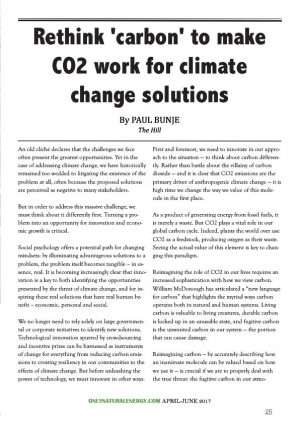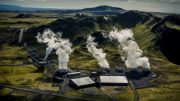 An old cliché declares that the challenges we face often present the greatest opportunities. Yet in the case of addressing climate change, we have historically remained too wedded to litigating the existence of the problem at all, often because the proposed solutions are perceived as negative to many stakeholders.
An old cliché declares that the challenges we face often present the greatest opportunities. Yet in the case of addressing climate change, we have historically remained too wedded to litigating the existence of the problem at all, often because the proposed solutions are perceived as negative to many stakeholders.
But in order to address this massive challenge, we must think about it differently first. Turning a problem into an opportunity for innovation and economic growth is critical.
Social psychology offers a potential path for changing mindsets: by illuminating advantageous solutions to a problem, the problem itself becomes tangible – in essence, real. It is becoming increasingly clear that innovation is a key to both identifying the opportunities presented by the threat of climate change, and for inspiring these real solutions that have real human benefit – economic, personal and social.
We no longer need to rely solely on large governmental or corporate initiatives to identify new solutions. Technological innovation spurred by crowdsourcing and incentive prizes can be harnessed as instruments of change for everything from reducing carbon emissions to creating resiliency in our communities to the effects of climate change. But before unleashing the power of technology, we must innovate in other ways.
First and foremost, we need to innovate in our approach to the situation — to think about carbon differently. Rather than battle about the villainy of carbon dioxide — and it is clear that CO2 emissions are the primary driver of anthropogenic climate change — it is high time we change the way we value of this molecule in the first place.
As a product of generating energy from fossil fuels, it is merely a waste. But CO2 plays a vital role in our global carbon cycle. Indeed, plants the world over use CO2 as a feedstock, producing oxygen as their waste. Seeing the actual value of this element is key to changing this paradigm.
Reimagining the role of CO2 in our lives requires an increased sophistication with how we view carbon. William McDonough has articulated a “new language for carbon” that highlights the myriad ways carbon operates both in natural and human systems. Living carbon is valuable to living creatures, durable carbon is locked up in an unusable state, and fugitive carbon is the unwanted carbon in our system — the portion that can cause damage.
Reimagining carbon — by accurately describing how an inanimate molecule can be valued based on how we use it — is crucial if we are to properly deal with the true threat: the fugitive carbon in our atmosphere. Regardless of the precise mix of fuels in a future low-carbon energy system, most estimates indicate that our energy supply will rely on fossil fuels for the foreseeable future. This means that reducing carbon dioxide emissions from fossil fuel burning is critical, even as other strategies for reducing emissions are ramped up.
Teams in the NRG COSIA Carbon XPRIZE are rapidly developing the best ways to do just that. Twenty-seven semi-finalist teams from around the world are currently testing technologies that turn the carbon dioxide produced from electricity generation from fossil fuels into products that can be sold in the marketplace.
Products being produced include an incredible array of possible working carbon uses: concretes and other building materials, liquid fuels, proteins for fish feed, precursors for paints and fertilizers, and advanced materials such as graphene and nanotubes.
This is an early win for innovation: Carbon XPRIZE teams are showing that fugitive carbon (the waste from electricity generation) can be turned into working carbon that serves as a feedstock to help power our daily lives.
In success, these innovators will demonstrate that building new markets and earning a profit can be key solutions to reducing the flow of CO2 into our atmosphere. All of these solutions are a demonstration of the vast potential for innovators to turn the climate challenge into an opportunity. Governments can provide guidance, incentives and support. Actions that include appropriate tax incentives, preferred purchasing guidelines, and loan guarantees that provide confidence to investors would be incredibly helpful in unleashing the power of innovators to develop new technologies with real market potential.
We must direct the human spirit of innovation to view the CO2 problem as an opportunity to create a better future. We need to accelerate innovation through investment and incentive to tackle the challenge while realizing the opportunity it presents.
By providing the right incentives and opening up the power of solving to anyone through tools like prizes and crowdsourcing, we can turn a new perspective on carbon into an industry of climate opportunity. This new perspective can lead to profit and new market growth. Societally, reimagining the causes of our problems is vital to see the opportunities for solving them.
Paul Bunje
Originally published
by The Hill
February 25, 2017





